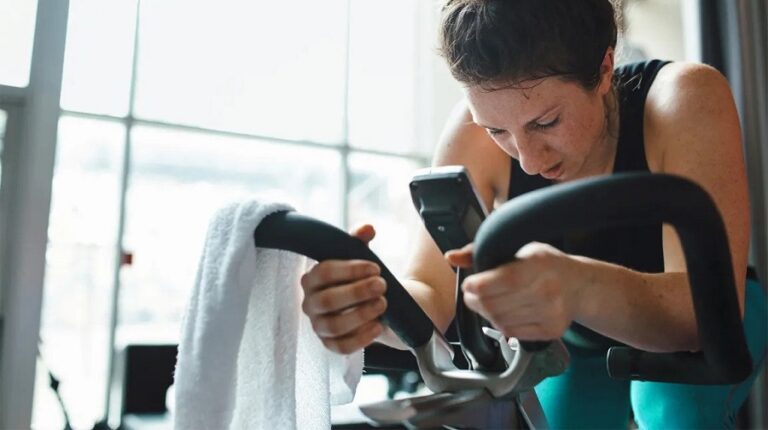Exercising regularly is a great way to help you stay fit at any age, and as you get older, staying active becomes even more crucial.
If exercise is already a part of your everyday life, great, but what can you do if you have mobility issues that prevent you from participating in certain types of activities?
While exercise can be challenging for people with limited mobility, you can still make great strides toward your fitness goals. Read on to find out where to start, and what examples of chair exercises are good for older people.
Example of exercise routine for seniors
If you are thinking about doing chair exercises but don’t know where to start, the following 10 exercises are great options. These exercises target different parts of the body, including the arms, trunk, and legs, in addition to some gentle stretching exercises.
Here’s a simple exercise routine for seniors:
1. Seated bicep curl
Sit in a chair with your hips back, your torso firm, and your back against the back of the chair. While using a set of dumbbells or an elastic band, start with your arms down and your elbows in, then bend your arms toward your shoulders and lower them back to the original position.
2. Seated openings
Sit in your chair so that your back is against the back of the chair. Start by raising both elbows to shoulder height, if you prefer you can use light dumbbells. Keep your elbows at shoulder height and bring your elbows toward the center until they touch. Go back to the starting position.
3. Extended leg raises
Sit near the front edge of the chair and grasp the sides of the seat with your hands. Spread both legs out in front of you with your toes pointing upward. With a straight back and a tight abdomen, slowly raise your legs, as high as you can before returning to the starting position.
4. Seated shoulder press
Sit in your chair with your back against the back of the chair. With a tight abdomen and a straight back, begin by holding a dumbbell in each hand and your arms raised and bent at a 90-degree angle, with your elbows out to the sides of your body.
With your palms facing up, extend your arms up, keeping them parallel until they are fully extended. Then slowly lower your arms to the starting position.
5. Seated ball spins
Sit toward the front edge of the chair. With a tight abdomen and a straight back, hold a medicine ball or other heavy object in front of you. Bend your elbows and turn your upper body to the left, come back to the center, then turn to the right and back to the center.
6. Seated Triceps Extension
Sit in your chair so that your back is against the back of the chair. Begin by raising one elbow in the air with a dumbbell in hand. Let the dumbbell fall back before slowly lifting it over your head while supporting your elbow with your other hand. Go back to the starting position.
7. Seated side stretch
Sit toward the edge of the chair with your back straight and your feet flat on the floor. With one hand, grip the seat for stability, then raise the other hand toward the ceiling in a curved position. Slowly bend in the direction of the extended arm, hold for 10 to 20 seconds, then return to a straight position before
8. Seated hip stretch
Sit in your chair with your feet flat on the floor and your core taut. Cross one leg over the other leg so that the ankle of the crossed leg extends beyond the lower leg. With your back straight, slowly lean forward as much as you can. Hold for 10 to 20 seconds and repeat before alternating with the opposite leg.
9. Optional Exercises – Chair Lunges
Place the chair against the wall. Place the ball of one foot on the seat and the other forward. Raise one leg in front of you until it is fully extended, then slowly return to the starting position. Repeat with the other leg.
10. Optional exercises – Planks with chair
This is an exercise for seniors with an advanced level chair. Lean the chair against the wall to ensure stability. With your elbows on the seat try to form a straight line across your body. Look down at the hands and press the abdominal area. If the posture is easy for you to maintain, you can try bringing your knees toward your chest.
Benefits of exercise
Exercise can improve your physical health and well-being. It can also help you manage your weight, which can help prevent serious medical conditions, such as heart disease, stroke, diabetes, high blood pressure, and obesity.
Exercise produces endorphins, which are “feel good” hormones, so exercising regularly can also improve your mental health, improve the quality of your sleep, relieve stress, anxiety, and improve your mood.
Regular exercise can also improve your balance and flexibility. Exercise can increase your muscle strength and endurance and help prevent bone loss. Exercise can help you stay healthy, fit, and strong, which can reduce your risk of falls.
Risks and precautions
In any exercise program, there is the possibility of injury. It is important to talk to your doctor before starting any exercise routine to make sure you are doing the right exercises for you.
This is especially important if you have any mobility limitations or if you have recently had surgery or other medical procedures. Clarifying your plans with your doctor can help prevent injury and keep you safe as your health and fitness improve.
ABSTRACT
This is as good a time as any to start taking steps to improve your health and stay in shape, and these simple chair exercises may be just what you need to get started.







